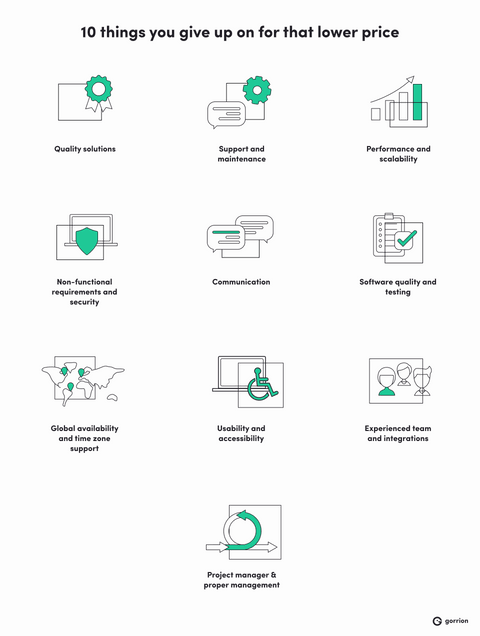

Blog

Buy cheap, buy twice – how low initial costs of IT projects can be misleading
Suspiciously low initial cost estimations almost never correspond to the actual price of the project. This is true not only of IT, but also of other industries. If you’ve ever had to fix your car or tried to build a house, you know what I mean.
In fact, this is such a universal truth that a very well-known joke now circulates among Poles:
“Will it be cheap?”
“It will be cheap.”
“Will it be good?”
“It will be cheap.”
Low cost fallacy
Many IT projects begin with an offer that proposes an attractive initial price estimate. Some software development companies and digital agencies simply dump their rates to attract clients and gain a competitive edge in the market. To the clients this seems advantageous – after all, they get the same deal they would get anywhere else, just for a lower price. But if you buy cheap does it really mean you won’t pay much overall?
The reality often shows that a low initial price will eventually reveal hidden costs in the long run. Therefore, if you get a project estimate that seems to be cheap as chips in comparison to proposals from other development companies or agencies, I do recommend that you think twice or even ten times before you reach for your wallet and blindly accept it.
Surprisingly, we observe that exceptionally low prices work like a magnet on new clients, especially those who tend to have little or no experience in building software. We obviously explain where our prices come from, how they speak to the quality of our work, and how they fairly accurately reflect the final cost. Unfortunately, clients often opt for the alluringly low prices of other companies. Only after wasting a pile of money do these clients return to us with an already failed project. And so, they pay twice.
10 things you give up on for that lower price
Unfortunately, echoing the English proverb ”buy cheap, buy twice,” we often find ourselves telling clients that their product will need rewriting due to poor code quality or inadequately designed architecture. Worse still, sometimes this means starting entirely from scratch.
“But why?” some may ask. Why does this happen?
Practically, there are many ways in which software development companies cut costs – all resulting in different flavors of disaster. Here are 10 things that you may be giving up on for that lower asking price, and how that may cost your IT project a fortune in the long run.
Quality solutions
Companies that offer very low prices may be forced to skimp on the quality of work, leading to poorly executed projects or applications. This, in turn, may necessitate later repairs, updates, or even a complete redesign of the system.
Support and maintenance
Low initial costs often don’t include expenses related to technical support, long-term maintenance, and system upkeep after deployment. Lack of adequate support can lead to system failures which require urgent intervention and additional costs.
Performance and scalability
Failure to consider anticipated traffic, daily peak loads, and monthly active users (MAU) may result in poor application performance and scalability issues. Scalability is essential for smooth operation under varying loads and later growth. To make matters worse, if a company needs additional features post-deployment and the system is not ready for them, it may lead to significant costs.
Non-functional requirements and security
Low-cost projects often overlook non-functional requirements (such as stability or data integrity) and security considerations. Ignoring security measures can lead to vulnerabilities and potential data breaches, resulting in significant financial and reputational damage.
Communication
Low-cost projects may suffer from inadequate communication between the team and the client. Lack of regular meetings, updates, and clear channels of communication can lead to misunderstandings, delays, and rework, ultimately impacting project timelines and costs. This is especially true of cross-collaborating teams.
Software quality and testing
Low-cost projects may cut corners on comprehensive testing and quality assurance. Inadequate testing can result in undetected bugs, performance issues, and usability problems, leading to dissatisfaction among users and increased support costs.
Global availability and time zone support
Applications should be accessible in different countries and support various time zones to cater to a global audience. While this is obvious to good developers, it’s also time- and resource-consuming, which is why cheap agencies hide that cost from the original estimate and charge extra for it later.
Usability and accessibility
We observe that, for the sake of saving time and money, multiple agencies skip this important aspect. User experience considerations, including responsive web design (RWD) and a mobile-first approach, are essential for ensuring the application is user-friendly and accessible across different devices and platforms.
Experienced team and integrations
One way for companies to lower development costs is to simply hire junior developers with lower salary brackets. However, these inexperienced teams may lack the expertise needed to integrate third-party solutions or handle complex integrations. This can lead to compatibility issues, system failures, and additional costs in the long run.
And last but not least:
Project manager & proper management
A lack of or poor project management can have a terrible effect on the business losing reputation and money. I do agree with what Benjamin Franklin once said: ““If you fail to plan, you are planning to fail”. Speaking from my own experience, were I to start an IT project, I would never go with a company that doesn’t have a manager as a part of the team. Every project needs a person that will deal with the daily coordination of the project team, managing the project budget, troubleshooting, risk management, or taking care of proper communication. Undoubtedly, such a manager is a must-have and their presence will translate into lower project costs and faster achievement of project goals.
Think about the big picture
In light of these challenges, companies should avoid being shortsighted in their assessment of IT project costs. Instead, they should consider both short-term and long-term costs. It’s better to invest a little more in a project that offers high quality, support, scalability, efficient communication, and robust testing than to risk problems and additional costs in the future.
Ultimately, while a low initial price may seem attractive, you should carefully examine all aspects of the project to avoid hidden costs and risks. Otherwise you may find that, as another proverb goes, “cheap is expensive.”





